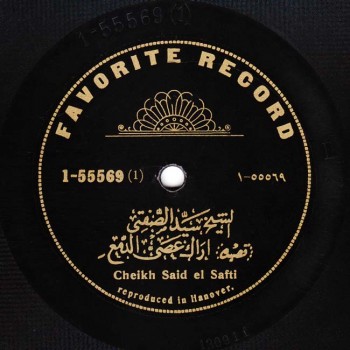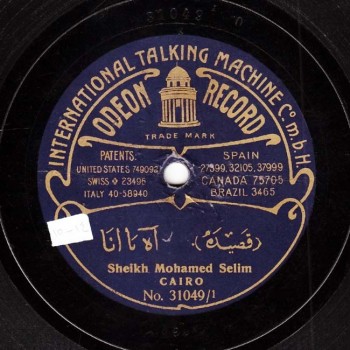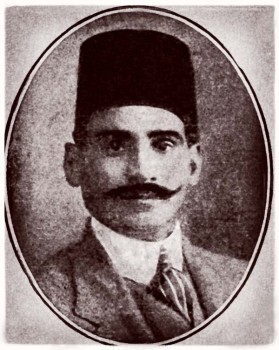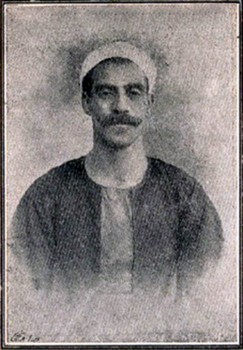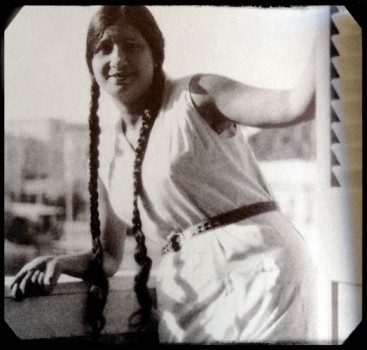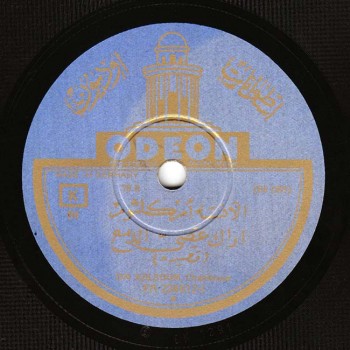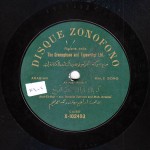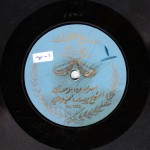Qaṣīda “Arāka ‘aṣiyy al-dam‘ ”
Written by Abū Firās al-Ḥamdānī.
It is the most famous qaṣīda sang during the Nahḍa period, and ‘Abduh Afandī al-Ḥāmūlī is said to have been the first ever to sing it at Khedive Ismā‘īl’s court.
Arāka ‘aṣiyy al-dam‘i shīmatuka al-ṣabru Amā li-al-hawa nahyun ‘alayka wa lā amru?
Bala anā mushtāqun wa ‘indiya law‘atun Wa lakinna mithliya lā yudhā‘u lahu sirru
Idhā al-laylu aḍwānī basaṭtu yada al-hawa Wa adhlaltu dam‘an min khalā’iqihi al-kibru
Takādu tuḍī’u al-naru bayna jawāniḥī Idhā hiya adhkathā al-ṣabābatu wa-al-fikru
Mu‘allilatī bi-al-waṣl wa-al-mawtu dūnahu Idhā muttu ẓam’ānan fa-lā nazala al-qaṭru
Wafaytu wa fī ba‘ḍi al-wafā’i madhallatun Li-ānisatin fī al-ḥayyi shīmatuhā al-ghadru
Tusā’ilunī man ant wa hiya ‘alīmatun Wa hal li-fatan mithlī ‘ala ḥālihi nukru
Fa-qultu kamā shā’at wa shā’a lahā al-hawa Qatīluki qālat ayyuhum fahumu kuthru
Wa ḥārabtu ahlī fī hawāki wa innahum Wa iyyāya lawlā ḥubbuki al-mā’u wa-al-khamru
Wa qālat laqad adhra bika al-dahru ba‘danā Fa-qultu ma‘ādha Allāhi bal anti lā al-dahru
Wa qallabtu amrī lā ara liya rāḥatan Idhā al-baynu ansānī alaḥḥa biya al-hajru
Wa ‘udtu ila ḥukmi al-gharāmi wa ḥukmihā Lahā al-dhanbu lā tujza bihi wa liya al-‘udhru
Wa qāla uṣayḥābī al-firāru awi al-rada Fa-qultu humā amrāni aḥlāhumā murru
When recording started in Egypt, singers including mashāyikh and afandiyyāt competed in order to record this qaṣīda. A same muṭrib sometimes even recorded it more than once, such as ‘Abd al-Ḥayy Afandī Ḥilmī who recorded it four times at least.
During this episode, we will listen to several recordings of this qaṣīda and compare them.
Muḥammad Salīm’s recording is the first recording of this qaṣīda that reached us. It was made in 1905 by Odeon on two sides of a 27cm record, order # 31049 1 and 2, matrix # EX 983 A and B, with Takht Odeon including Ḥāj Sayyid al-Suwaysī (‘ūd), ‘Abd al-‘Azīz Afandī al-Qabbānī (qānūn), and ‘Alī Afandī ‘Abduh Ṣāliḥ (nāy).
The second recording is of ‘Abd al-Ḥayy Afandī Ḥilmī made by Odeon around 1906, order # 45287 1 and 2, matrix # EX 1287 A and B, on two sides of a 27cm record, with Takht Ibrāhīm Afandī Sahlūn (kamān), Muḥammad Afandī Ibrāhīm (qānūn). Zonophone –daughter company of Gramophone– also recorded ‘Abd al-Ḥayy’s performance of this qaṣīda with the two same musicians. That same year, ‘Abd al-Ḥayy Afandī recorded it on three 25cm record sides, order # X-102493, X-102494, X-102495, matrix # 7794 B, ½ B, and ⅓ B.
S
heikh Sayyid al-Ṣaftī recorded it with Favorite Record Company in the early 1920s on two sides of a 25cm record, order # 1-55569 1 and 2, matrix # 1309 I F and II F.
There is a strange recording of Muṣṭafa Sayyid Aḥmad al-Rashīdī and his band. It was made in the mid 1920s, probably in 1924, by Odeon on one side of a 27cm record, order # X 47905, matrix # EX 2646.
In the early 1930s, Miss Umm Kulthūm Ibrāhīm also recorded it with Odeon –this time through electrical power-printing– on two sides of a 25cm record, order # FA 224612 I and II, matrix # EK 1291 and EK 1292.
Finally, we will listen to Ṣāliḥ Afandī ‘Abd al-Ḥayy –son of ‘Abd al-Ḥayy Afandī Ḥilmī’s sister– singing this qaṣīda. This recording was taken from Ṣāliḥ Afandī’s Egyptian National Radio recorded waṣla at least 40 years after his uncle’s recording.
December 3rd 1964… First Thursday of the month… The “Qaṣr al-Nīl” movie theatre crowded with chic men smoking nervously, ladies wearing diamond necklaces laughing with their friends. Loud applauds …
The red curtain unveils the Sitt and silence prevails …
A lady gasps, another one stares:
There is a strange intrusive shape to the Sitt’s left, something that does not suit her, or maybe contradicts what she represents. Umm Kulthūm knows perfectly well why her audience is surprised, she smiles a mysterious smile. The strange shape, the strange instrument: a piano. What is a piano doing in a Sitt concert? Why does “Kawkab al-Sharq” need this instrument to her left? What are these strange sounds?
Let us listen to the piano.
We will listen to the piano…
But hadn’t the audience already gasped once before during the previous season, when they saw the guitar in Saḥḥāb’s concert.
In fact, this had happened during the previous season and in the same year.
So what did she want to prove? Why? What is the reason behind this sophistication? What was Riyāḍ al-Sunbāṭī trying to prove? Why?
In order to answer this question, we must go back 60 years.
Really?
Really.
Alright.
This was year 1964.
Let’s go to Cairo in 1904 at the beginning of the commercial recording era in the Middle-East. Sheikh Muḥammad Salīm is sitting by himself, only surrounded by the takht, in front of the big brass horn, getting ready to chant a qaṣīda he has heard over and over sang by his teacher –maybe, the great ‘Abduh Afandī al-Ḥāmūlī deceased only four years earlier. He had heard him singing verses excerpted from the dīwān of Abū Firās al-Ḥamdānī: “Arāka ‘aṣiyy al-dam‘i shīmatuka al-ṣabru; Amā li-al-hawa nahyun ‘alayka..
… wa lā amru?”
Na‘am anā mushtāqun wa ‘indiya law‘atun…”. Who is the genius who thought of changing the lyrics of Abū Firās al-Ḥamdānī’s verses? Abū Firās al-Ḥamdānī wrote: “Bala anā mushtāqun wa ‘indiya law‘atun”. Who is the genius who was inspired to say “Na‘am” (Yes) instead of “Bala” (Indeed)? “Na‘am” is much more beautiful, and “Na‘am” allows the muṭrib to perform for us the ghunna, the madd …, and all the forms of…
However, the answer to the question “Amā … ?” can’t be “Na‘am” (Yes). In this context, “Na‘am” negates: thus “Amā li-al-hawa nahyun ‘alayka wa lā amru?” (Can love neither ruin nor rule you?” implies the answer: “Na‘am, laysa li-al-hawa nahyun ‘alayhi wa lā amru” (Yes, love can neither ruin nor rule him).
That is true, but your answer shows that you are thinking as a linguist. You should think like a muṭrib. I expected you to think like a muṭrib and not like …
A linguist?
Not like a linguist.
Alright.
But strange … Do you think Ismā‘īl Ṣabrī is the one who conducted these changes? Or was it ‘Abduh Afandī?
It may have been ‘Abduh Afandī. But we can’t answer this question. We know perfectly well that these music professionals were often surrounded by a large number of men of letters. Before even thinking of the issue of changing “Bala” into “Na‘am”, the logical question is basically: “Who chose these specific verses? Or, who proposed to ‘Abduh al-Ḥāmūlī to sing these specific verses? Was it ‘Abduh al-Ḥāmūlī himself –who used to read old poetry dawāwīn as well as Al-Bārūdī’s chosen works– who then chose them? Or did someone go to him after judging these verses to be compatible with singing, ghazal, and ‘Abduh al-Ḥāmūlī’s style in singing? God only knows.
In general…?
In general, it is part of Abū Firās al-Ḥamdānī’s rūmiyyāt –these qaṣā’id he wrote in a Byzantine prison while waiting for his cousin Sayf al-Dawla who took his time in bailing him out.
Let us go back to Muḥammad Salīm in 1904… So, he is sitting in front of the brass horn and remembering what he has heard previously. Of course, added to ‘Abduh al-Ḥāmūlī’s concerts, he has also listened to ‘Abduh al-Ḥāmūlī’s poor quality cylinder records. But this is the era of modernism. 1904 is the new century and the era of the disc whose quality is much better of course. So here he is, recording the qaṣīda ‘ala al-waḥda to the bayyātī maqām, exactly as ‘Abduh Afandī sang it.
Actually, the label on the album says: Qaṣīda “Āh yā anā”…
Because it is preceded by “dūlāb al-‘awādhil”: “Āh yā anā we-ēsh li-el -‘awādhil ‘andinā, ūm maḍya‘ el-‘udhdhāl we-wāṣilnī anā”. We can also ask the following question: “Who is the genius who thought of adding these verses or this verse originally taken from a dawr to the sīkāh, and placed these lyrics at the beginning of all the qaṣā’id that were sang at the beginning of the 20th century? This tradition indeed appeared with the Nahḍa’ school, maybe in the mid 19th century. Did ‘Abduh al-Ḥāmūlī invent it? Did ‘Abduh al-Ḥāmūlī’s generation invent it? These are some of the questions we vainly try to answer (because they are difficult to answer). We are perfectly aware that we will never find the answers.
Almost all the Nahḍa period’s muṭribīn in turn recorded their own personal version of these verses. Still all these versions were to the bayyātī maqām out of respect for the tradition established by ‘Abduh Afandī, and always abiding by the same structure –undoubtedly Al-Ḥāmūlī’s structure– i.e. the beginning to the bayyātī then the progression …
… The shiftings …
Yes the shiftings.
… depending on the verses…
These melodic shiftings were undoubtedly ‘Abduh al-Ḥāmūlī’s, and everybody respected those even when they added their own variations.
Except for ‘Abd al-Ḥayy Ḥilmī in one of his versions. We will come across this issue a little later …
Actually, we always listen to this qaṣīda preceded by “dūlāb al-‘awādhil”, at least in the recordings made before WW1 which include ‘Abd al-Ḥayy Ḥilmī’s recording.
Let us now listen to the beginning of ‘Abd al-Ḥayy Ḥilmī’s recording made by Odeon. Note the enthusiasm of kamanjātī (violinist) Ibrāhīm Sahlūn when ‘Abd al-Ḥayy Ḥilmī says: “Na‘am anā mushtāqun wa ‘indiya law‘atun, Wa lakinna mithlī lā yudhā‘u lahu sirru”. Ibrāhīm Sahlūn invites ‘Abd al-Ḥayy Ḥilmī to repeat the sentence, and says to him: “Aywa kamān ṭunni we-el-nabī” (Sing it again, by God!).
In his magazine ““Rawḍat al-Balābil”, Lebanese music critic Iskandar Shalfūn mentions that a certain eloquent performer used to say: “Idhā muttu ẓamqānan fa-lā nazala al-qaṭru”.
… ẓamqānan … ?
Qasṭandī Rizq adds that, in one of his concerts, Al-Ḥāmūlī pronounced the letter “ẓ” in a tajwīd style i.e. between his teeth, and that the audience was surprised by such eloquence … “Idhā muttu ẓam’ānan fa-lā nazala al-qaṭru” (emphasizing the “ā”).
Well, the man had been brought up by the mashāyikh …
Of course, but since he had been brought up by the mashāyikh, wasn’t he supposed to say “ẓam’ān” without emphasizing the “ā”?
Muḥammad Salīm says “ẓam’ānan” without emphasizing the “ā”.
Because he was a Sheikh.
How does Sayyid al-Ṣaftī pronounce it? Let us listen to him.
Did you hear it? He says: “Idhā muttu ẓam’ānan” without emphasizing the “ā”.
Let us end part 1 of our discussion about qaṣīda “Arāka ‘aṣiyy al-dam‘ ” with this special and marvellous recording of Sayyid al-Ṣaftī made by Favorite Record Company.
We thank Prof. Frédéric Lagrange for his great analysis and explanation.
We will meet again with part 2 of our discussion about qaṣīda “Arāka ‘aṣiyy al-dam‘ ”.
- 221 – Zakariyya Ahmed – 12 (1/9/2022)
- 220 – Zakariyya Ahmed – 11 (1/9/2022)
- 219 – Zakariyya Ahmed – 10 (11/25/2021)
- 218 – Zakariyya Ahmed – 9 (10/26/2021)
- 217 – Zakariyya Ahmed – 8 (9/24/2021)
- 216 – Zakariyya Ahmed – 7 (9/4/2021)
- 215 – Zakariyya Ahmed – 6 (8/28/2021)
- 214 – Zakariyya Ahmed – 5 (8/6/2021)
- 213 – Zakariyya Ahmed – 4 (6/26/2021)
- 212 – Zakariyya Ahmed – 3 (5/27/2021)
- 211 – Zakariyya Ahmed – 2 (5/1/2021)
- 210 – Zakariyya Ahmed – 1 (4/28/2021)
- 209 – W-al-Lāhi lā astaṭī‘u ṣaddak 2 (4/6/2017)
- 208 – W-al-Lāhi lā astaṭī‘u ṣaddak 1 (3/30/2017)
- 207 – Bashraf qarah baṭāq 7 (3/23/2017)

